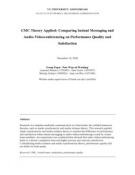VU UNIVERSITY AMSTERDAM
FACULTY OF ECONOMICS AND BUSINESS ADMINISTRATION
CMC Theory Applied: Comparing Instant Messaging and
Audio-Videoconferencing on Performance Quality and
Satisfaction
December 16, 2009
Group Paper ‘New Ways of Working’
Lennaert Peeters (1735950) - Sani Gouw (1627937)
Martijn Scheen (1808524) - Jaap van Nes (1471090)
Written under supervision of Sarah van der Land MA
Abstract
Research on computer-mediated communication in virtual teams has yielded numerous
theories, such as media synchronicity and media richness theory. This research applied
media synchronicity and media richness theory to explain the difference in performance
and satisfaction when instant messaging or audio-videoconferencing is used by virtual
team members. An experiment was conducted that showed that audio-videoconferencing
leads to a shorter completion time and higher process and outcome satisfaction.
Contradicting media richness and media synchronicity theory, performance quality did
not differ for both media.
Keywords: CMC, virtual teams, satisfaction, performance quality
,Table of Contents
1. Introduction ................................................................................................................... 3
1.1 Introduction ............................................................................................................... 3
1.2 Research question...................................................................................................... 4
1.3 Contributions ............................................................................................................. 4
1.4 Outline ....................................................................................................................... 5
2. Theoretical framework ................................................................................................. 6
2.1 Computer-mediated communication (CMC) ............................................................ 6
2.2 CMC with task and medium use ............................................................................... 7
2.2.1 TIP theory ........................................................................................................... 7
2.2.2 Media Richness & Synchronicity theory ............................................................ 8
2.2.3 Instant messaging and audio-videoconferencing................................................ 8
3. Hypotheses Development............................................................................................ 10
3.1 Completion time ...................................................................................................... 10
3.2 Outcome .................................................................................................................. 10
3.3 Process satisfaction ................................................................................................. 11
3.4 Outcome satisfaction ............................................................................................... 12
4. Methodology ................................................................................................................ 14
4.1 General information ................................................................................................ 14
4.2 Participants and groups ........................................................................................... 14
4.3 Design and independent variables ........................................................................... 14
4.4 Procedure................................................................................................................. 15
4.5 The task ................................................................................................................... 15
4.6 Dependent Variables ............................................................................................... 16
4.7 Measures.................................................................................................................. 16
5. Results .......................................................................................................................... 19
5.1 Time to complete ..................................................................................................... 19
5.2 Performance quality ................................................................................................ 19
5.3 Process and Outcome Satisfaction .......................................................................... 20
5.4 Control variables ..................................................................................................... 20
1
, 5.5 Summary of the hypotheses .................................................................................... 21
6. Discussion.................................................................................................................... 22
6.1 Conclusions ............................................................................................................. 22
6.2 Discussion ............................................................................................................... 22
6.2.1 General findings ............................................................................................... 22
6.2.2 Two views on performance quality .................................................................. 23
6.2.3 The level of task complexity ............................................................................ 24
6.3 Managerial implications .......................................................................................... 25
6.4 Limitations and Recommendations for Further Research ....................................... 25
References ........................................................................................................................ 27
Appendix A ...................................................................................................................... 30
Appendix B ...................................................................................................................... 31
2
,1. Introduction
1.1 Introduction
Over the last decade, researchers have enlightened many benefits and costs associated
with virtual teams (Bell & Kozlowski, 2002; Martins, Gilson, & Maynard, 2004). Virtual
team members are able to cooperate through computer-mediated communication (CMC)
and are structurally linked with the ability to perform tasks regardless of their physical or
organizational location (Townsend, DeMarie, & Hendrickson, 1998). This ability is
argued to enhance the quality of the decisions made by virtual teams, also because it is
possible to compose teams of the best individuals to perform the task, without having to
physically bring them together.
Within the field of virtual teams, it still remains unclear what specific technology
should be used to perform certain tasks. Media richness theory, media synchronicity
theory and the task-technology fit all pose to explain which medium fits best with certain
tasks (Daft & Lengel, 1984; Dennis, Fuller, & Valacich, 2008; Fuller & Dennis, 2009),
but in order to verify their theoretical arguments, more research has to be conducted.
Furthermore, most research on virtual teams and task performance is still focusing on the
differences between teams that communicate through CMC and team that meet face-to-
face (Straus & McGrath, 1994).
In this research media richness and media synchronicity theory are used to
analyze two specific CMC technologies, instant messaging and audio-video
conferencing, on their performance and satisfaction when virtual team members perform
a complex negotiation task. The reason for investigating the effect on both performance
and satisfaction is that next to already covered objective measures of outcome quality,
more subjective and social outcomes are also deemed important (Walther, 1996). Instant
messaging and audio-video conferencing further pose interesting CMC technologies from
a managerial perspective, because they are widely used in practice. Also the situation of
solving a complex negotiation task is common ground in business, for example when two
geographically dispersed managers need to discuss next year‟s budget.
Next to these practical differences both CMC technologies have also been
investigated in scientific studies. In terms of media richness and media synchronicity
3
, theory, instant messaging is indicated to be a leaner and lower synchronous technology
than audio-video conferencing (Daft & Lengel, 1984).
Therefore it is proposed that both technologies are suited for different types of
tasks. When performing a complex task, it is argued that audio-video conferencing leads
to both a higher team performance, operationalized as the outcome in both quality and
time to get to the outcome, and individual satisfaction, divided into a virtual team
members‟ process and outcome satisfaction.
1.2 Research question
The research question that will guide this research is stated as follows:
“How and to what extent do performance and satisfaction differ when using audio-
videoconferencing or instant messaging for performing a complex task?”
To answer this research question, several sub questions have to be answered:
- What are the differences between audio-video conferencing and instant messaging
as described by computer-mediated communication (CMC) theory?
- What is the relationship between task complexity and the use of CMC?
- How and to what extent does a communication method influence performance
and satisfaction?
1.3 Contributions
The main goal of this research is to apply general task-technology fit theories to compare
two specific CMC‟s on their performance and satisfaction, covering both objective and
subjective measure of a virtual team member‟s performance. Validating the theories such
as media synchronicity theory (Dennis et al., 2008) and media richness theory (Daft &
Lengel, 1984) strengthens the consensus about media use for certain tasks. Furthermore,
the dynamics of virtual teams are explored, thus pushing forward the literature by not
merely comparing CMC with face-to-face contact, but also delving deeper within the
field of virtual teams alone.
4





